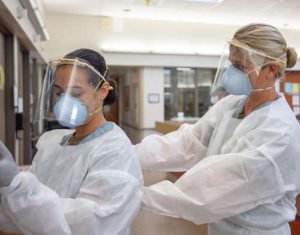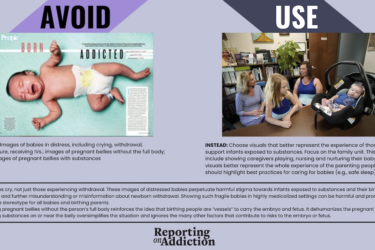
A half-hour before nursing supervisor Jotis Lee was scheduled to end her shift on the Friday before July 4th, the text came through: A 24-year-old who was fully vaccinated against COVID-19 had, nevertheless, contracted the virus and just been admitted to the Department of Veterans Affairs’ hospital.
That patient’s admission was another marker of the pandemic’s persistence, said Lee, who, at that Little Rock, Ark hospital, supervises a team of nurses in an outpatient clinic that mainly has done telehealth care during the pandemic.
“In many ways, the pressure has gotten worse,” Lee said, of the anxiety, depression and other stresses members of her team are experiencing.
“Today, I had to deliver the news to two of my nurses that we have to send them back to inpatient areas,” she said on that Friday afternoon, “not knowing at all whether they would come in contact with this new Delta variant.”
The 24-year-old patient’s blood was being tested to determine which strain of the virus he’d contracted, Lee said. Her own mother, who was 67, died of COVID complications, she added. So, did a beloved nurse colleague at her VA facility, she said.
“Overall,” Lee said, “many people are really discouraged about where this has been going or whether there will be an end to it. There’s been some anger and frustration … We’ve not been able to congregate like we usually do. No staff meetings, no potlucks. Wearing masks at all times, face shields and goggles. It’s a lot.”
Variations on that theme abound among many nurses nationwide, said health care consultant Nancy Spangle, a former psychiatric occupational therapist who has partnered with, among others, the Mid-America Coalition on Health Care and the American Psychiatric Foundation’s Partnership for Workplace Mental Health to conduct research.
Nurses were suffering a “burnout epidemic” well before the pandemic, Spangle said, given the nation’s chronic nursing shortage and the work overload that too many nurses face.
“The [National] Academy of Medicine started a resources center for employers and started writing about this three or four years ago,” Spangle said. “So, the industry has been looking at this. The pandemic just exacerbated many of the features of burnout and made the situation much worse.”
Spangle said institutions where nurses and other frontline health workers are best buffered against the specific burdens of COVID-19 have taken a top-down approach to employee wellness and established what she terms as resiliency micro-practices.
Such practices, nurse Lee noted, are her VA hospital’s daily “Take 10” recorded mindfulness exercise and “Moments With Matt,” a recorded update on the trajectory of COVID-19 in her state. Those updates, conducted by one of the VA’s infectious disease physicians, are becoming more frequent as the Delta variant ticks up, including in Arkansas where roughly 35% of the population is vaccinated.
“Individuals need to feel a responsibility to learn resilience strategies and micro-practices but you cannot face it alone,” Spangle said. “For nurses to be able to bounce back, there must be trust, fairness and a lot of communications so that people feel supported.”
The pandemic is forcing hospitals to consider their long-term plans to ensure mental wellness among they’re employees. That includes examining whether to hire in-house psychiatrists, psychologists and social workers to help manage worker stress, Spangle said.
Nurses are among the health care workers who clinical psychologist Joseph Banken, of Edmund, Okla., has counseled as a volunteer with Project Parachute, launched during the pandemic. In his private practice, he also counsels nurses, estimating they comprise about 3% of his patients.
What’s most surprised him are the number of nurses who’ve chosen to pay him out of pocket instead of having their health insurers pick up at least part of the tab. One nurse, who has been working extra hours to cover her counseling bill, told Banken she didn’t want anyone to know she was getting help.
“That is an additional stressor,” Banken said. “I’m hoping the pandemic, for all of us, will let us see that health care professionals need to be caretakers of one another. Getting help is a sign of strength, not of weakness.”
Nurses, he added, are “the workhorses of health care” and the pandemic has amplified that reality, too.
“They just saddle up and do the work,” Banken said. “You’ve got some doctors barking at them, demeaning them. Nurses often get assigned to give the bad news, explain it to the family. People who had COVID could not have their relatives come in, and the nurse was that link in the last moments of life. What you’ve got, when you take all of that on, is a very wounded healer.”
Brenda Roy, who retired as a nursing supervisor from that Little Rock VA hospital at the end of 2020, four years earlier than she’d planned, agreed. “The pandemic didn’t drive me out,” she said. “But some of the individuals who’d worked there for quite some time did retire early because of the pandemic. The daily changes in information coming down from leadership, the staffing shortages make the work incredibly hard. Taking 10 minutes every day to try and relax on the job is fine — if you’ve got the time to do that.
“People were pressed,” she said. “They just quit.”
Spangle noted that some nurses who showed up and put themselves at risk reached the breaking point. “They’re fatigued. They’re numb,” she said. “They lack any sense of doing their job with efficacy.”
But that isn’t true of all nurses, she added. There is anecdotal evidence, at least, that many nurses have felt more engaged in their work than ever during the pandemic. Generally, though, they work in institutions that are more forward-thinking and were better prepared to manage and support employees’ mental health during a worldwide crisis.
Additional sources of info:
- The American Nurses Association COVID-19 Resource Center.
- The National Nurses Union, which condemned the CDC’s May 2021 repeal of mask-wearing.
- The Emotional PPE Project also offers free counseling to health care workers.
- This April 2021 JAMA Psychiatry report compares pre-pandemic suicide rates of female nurses to those of other women workers.
- In mid-May, the California Health Care Foundation and Goodwin Simon Strategic Research released the third in a series of surveys of the state’s health care providers’ self-assessment of their mental wellness and morale during the pandemic.
Story ideas:
- How have employee assistance programs in health care been transformed, or not, by the pandemic?
- A day-in-the-life of a nurse amid COVID-19. (In addition to VA nurse Lee’s 7 a.m.-4 p.m. Monday through Friday work shift, she also was charged with being a VA vaccination clinic “pit boss,” setting up tents and overseeing vaccine clinics on nights and weekends; doing temperature checks on employees, including nurses who refused to take the COVID vaccine.)
- What does research suggests about nurses’ mental resiliency?
- Total Brain and the National Alliance for Health Care Purchaser Coalitions does a monthly webinar updating measurements of anxiety, depression, burnout, etc among nurses and other health professionals.
- In medical institutions that have not mandated the vaccine for workers, how have political and other divisions regarding COVID-19 affected mental health for anti-vaccine nurses and vaccinated nurses who are working side by side?







